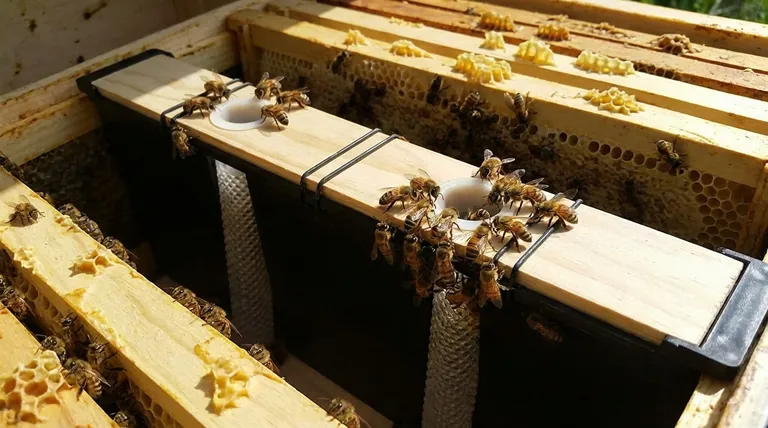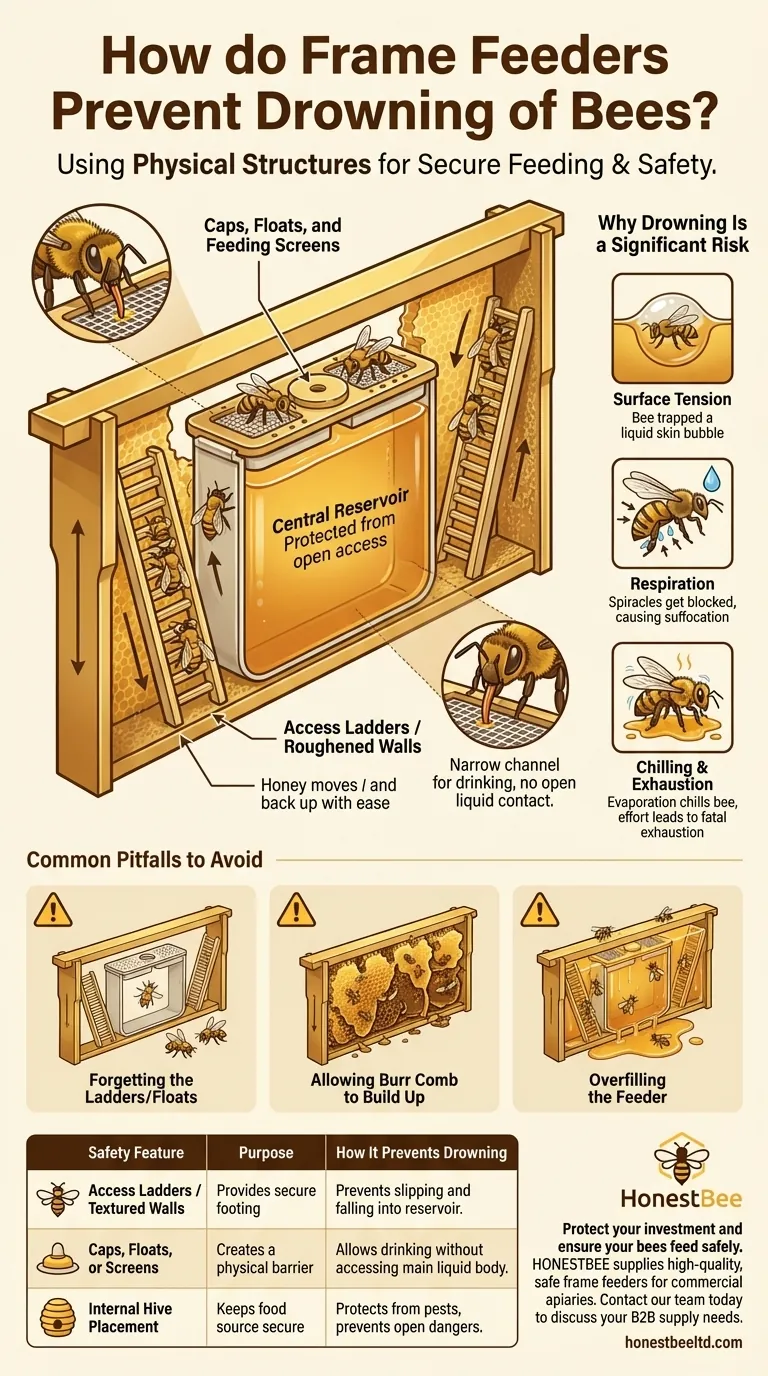At its core, a frame feeder prevents bees from drowning by using physical structures to separate them from the bulk of the liquid syrup. These feeders are specifically designed with components like textured inner walls, ladders, and floats that allow bees to securely access the food without the risk of falling into and becoming trapped by the syrup.
The fundamental principle of a frame feeder is to provide a controlled feeding interface. It creates a safe platform where bees can drink without ever coming into contact with the large, open surface of the liquid reservoir, effectively eliminating the primary cause of drowning.

The Anatomy of a Safe Frame Feeder
To understand how these feeders work, it's essential to break down the key design components that prioritize bee safety. Each element serves a specific purpose in preventing access to the main liquid body.
The Central Reservoir
The main body of the feeder is a sealed container that holds the sugar syrup. Its placement inside the hive, taking the place of one or more frames, keeps the food source secure and protected from outside pests.
Access Ladders or Roughened Walls
Bees need a secure path to travel from the top of the feeder down to the syrup. Frame feeders incorporate features like plastic "ladders" or heavily textured interior walls that provide a rough surface.
This design gives the bees ample footing to climb down and, more importantly, to climb back up after feeding. It prevents them from slipping and falling into the syrup below.
Caps, Floats, and Feeding Screens
This is the most critical safety feature. A cap, float, or screen covers the open reservoir, creating a physical barrier. This barrier leaves only a very narrow, confined space for the syrup to be accessed.
Bees stand safely on the ladder or float and extend their proboscis (tongue) into this small channel to drink. They are never able to walk on or fall into the main body of liquid, which is the primary danger with open containers.
Why Drowning Is a Significant Risk
Understanding why bees drown so easily in open liquid highlights the importance of these feeder designs. The danger comes down to a combination of physics and bee biology.
The Hazard of Surface Tension
For a small insect like a honeybee, the surface tension of water or sugar syrup is incredibly strong. If a bee falls in, this "skin" on the liquid can trap its legs and wings, making escape nearly impossible.
The Role of Respiration
Bees do not have lungs. They breathe through small openings along their bodies called spiracles. If a bee becomes covered in a liquid like syrup, these spiracles get blocked, and the bee quickly suffocates.
Chilling and Exhaustion
Even if a bee manages to pull itself out of the liquid, being coated in syrup is often a death sentence. The evaporation of the liquid chills the bee rapidly, and the effort of cleaning itself can lead to fatal exhaustion.
Common Pitfalls to Avoid
While effective, frame feeders are not without their operational considerations. Proper management is key to their success and the safety of the colony.
Forgetting the Ladders or Floats
The most common mistake is failing to install all the safety components. Using a frame feeder without its internal ladders or floats turns it into a dangerous drowning pool for the bees.
Allowing Burr Comb to Build Up
If a feeder is left in the hive empty, bees will often begin building burr comb inside it. This can interfere with the function of the floats and must be cleaned out before refilling.
Overfilling the Feeder
Overfilling can cause the syrup to spill over the safety barriers when the feeder is placed into the hive. This can drown the bees that are immediately underneath it and create a sticky mess.
Making the Right Choice for Your Goal
Selecting a feeding method depends entirely on your hive's specific needs and your management style.
- If your primary focus is maximum bee safety: The frame feeder is an excellent choice due to its integrated safety mechanisms that minimize the risk of drowning.
- If your primary focus is feeding a colony rapidly with minimal intrusion: You might consider an external hive-top feeder, but be aware that these also require careful attention to prevent drowning.
- If your primary focus is avoiding pests and robbing: The internal nature of a frame feeder makes it superior to entrance feeders, which can attract unwanted attention.
Ultimately, choosing a well-designed feeder and using it correctly is a critical step in supporting a healthy and thriving bee colony.
Summary Table:
| Safety Feature | Purpose | How It Prevents Drowning |
|---|---|---|
| Access Ladders / Textured Walls | Provides secure footing | Prevents bees from slipping and falling into the syrup reservoir. |
| Caps, Floats, or Screens | Creates a physical barrier | Allows bees to drink from a narrow channel without accessing the main liquid body. |
| Internal Hive Placement | Keeps food source secure | Protects syrup from outside pests and prevents open, dangerous feeding scenarios. |
Protect your investment and ensure your bees feed safely. HONESTBEE supplies commercial apiaries and distributors with high-quality, well-designed frame feeders that prioritize bee safety. Our wholesale-focused operations provide the reliable equipment you need to maintain healthy, productive colonies. Contact our team today to discuss your beekeeping supply needs.
Visual Guide

Related Products
- Professional In-Hive Frame Bee Feeder by HONESTBEE
- 3.5L Plastic Beehive Frame Feeder Deep Frame Water Feeder for In Hive Use
- In-Hive Dual Compartment Frame Bee Feeder for Targeted Colony Nutrition
- Boardman Entrance Bee Feeder Durable Galvanized Steel and Wood Construction for Beekeeping
- Professional Hive Front Entrance Bee Feeder
People Also Ask
- What are frame feeders, and what are their advantages? Essential for Cold Weather & Efficient Feeding
- What are the different types of honey bee feeders? Choose the Right Feeder for Your Hive
- What are the advantages of using a frame feeder? Boost Hive Health with In-Hive Feeding
- What are the two most popular types of honey bee feeders? A Guide to Frame and Bucket Feeders
- What is a frame feeder and how does it work? An Efficient In-Hive Feeding Solution



















